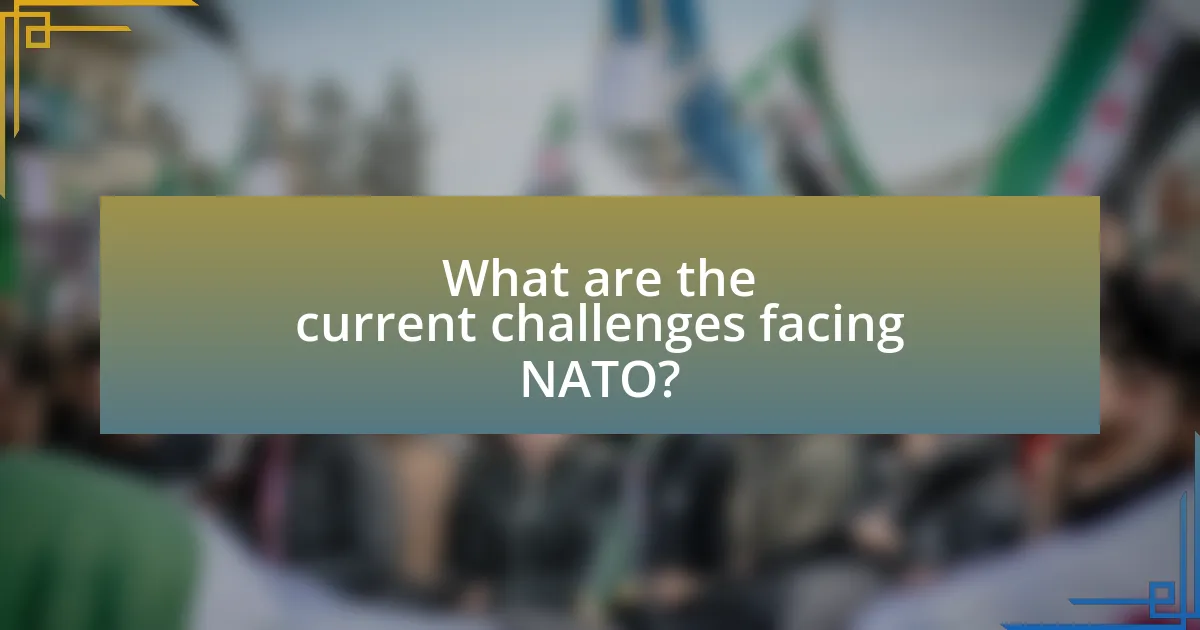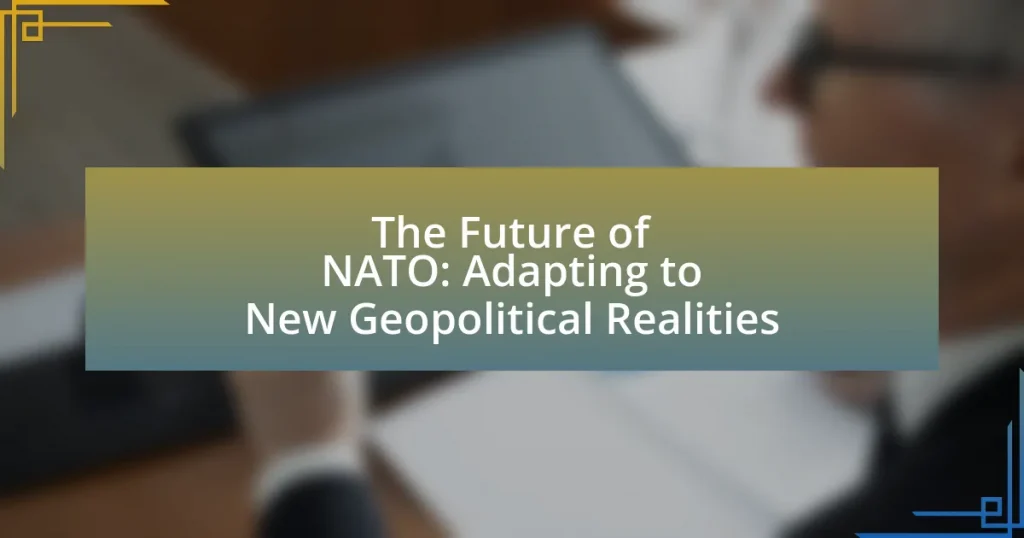The article examines the future of NATO as it adapts to new geopolitical realities, focusing on significant challenges such as geopolitical tensions with Russia, the rise of China, and internal cohesion among member states. It highlights how these factors influence NATO’s strategy, including enhanced military readiness and collective defense measures. The article also discusses the impact of non-state actors, defense spending disparities, and differing national interests on NATO’s effectiveness. Additionally, it outlines NATO’s strategic initiatives, partnerships beyond Europe, and the importance of technology in addressing emerging security threats, ultimately emphasizing the alliance’s commitment to maintaining stability in a rapidly changing global landscape.

What are the current challenges facing NATO?
NATO currently faces several significant challenges, including geopolitical tensions with Russia, the rise of China, and internal cohesion among member states. Geopolitical tensions with Russia have escalated due to the ongoing conflict in Ukraine, prompting NATO to enhance its deterrence and defense posture in Eastern Europe. The rise of China presents a new strategic challenge, as NATO must consider how to address security concerns in the Indo-Pacific region while maintaining focus on the Euro-Atlantic area. Additionally, internal cohesion is tested by differing priorities among member states, particularly regarding defense spending and military commitments, which can undermine collective security efforts. These challenges necessitate a strategic reassessment of NATO’s role and capabilities in a rapidly changing global landscape.
How do geopolitical tensions influence NATO’s strategy?
Geopolitical tensions significantly influence NATO’s strategy by prompting the alliance to adapt its military posture and operational focus. For instance, the resurgence of Russian aggression, particularly the annexation of Crimea in 2014, led NATO to enhance its collective defense measures, including the deployment of multinational battlegroups in Eastern Europe. This strategic shift is evidenced by the increased defense spending commitments from member states, which rose to an average of 2% of GDP by 2024, reflecting a direct response to perceived threats. Additionally, NATO’s emphasis on rapid response capabilities and enhanced deterrence strategies illustrates how geopolitical dynamics shape its operational framework.
What role do Russia and China play in shaping NATO’s future?
Russia and China significantly influence NATO’s future by presenting strategic challenges that compel the alliance to adapt its defense posture and operational strategies. Russia’s military actions, such as the annexation of Crimea in 2014 and ongoing military presence near NATO borders, have prompted NATO to enhance its deterrence measures, including increased troop deployments in Eastern Europe. Similarly, China’s growing military capabilities and assertive policies in the Indo-Pacific region have led NATO to consider broader security implications beyond Europe, fostering partnerships with countries like Japan and Australia. These developments necessitate a reevaluation of NATO’s collective defense strategies and its role in global security dynamics, as evidenced by NATO’s 2022 Strategic Concept, which explicitly identifies both Russia and China as challenges to Euro-Atlantic security.
How does the rise of non-state actors impact NATO’s operations?
The rise of non-state actors significantly complicates NATO’s operations by introducing asymmetric threats that challenge traditional military strategies. Non-state actors, such as terrorist organizations and insurgent groups, operate outside the control of nation-states, making them difficult to target and counter. For instance, the emergence of groups like ISIS has forced NATO to adapt its strategies, focusing on counter-terrorism and intelligence-sharing among member states. This shift is evidenced by NATO’s involvement in operations in Afghanistan and Iraq, where it has had to collaborate with local forces and address the influence of non-state actors on regional stability. Consequently, NATO’s operational framework now emphasizes flexibility, rapid response, and enhanced cooperation with non-military entities to effectively address these evolving threats.
What internal challenges does NATO face?
NATO faces several internal challenges, including differing national priorities among member states, varying levels of military spending, and political divisions regarding collective defense strategies. These challenges are evident as member countries often prioritize their own national interests over collective goals, leading to inconsistencies in defense commitments. For instance, NATO’s guideline suggests that members should spend at least 2% of their GDP on defense, yet only a handful of countries meet this target, creating disparities in military capabilities. Additionally, political disagreements, such as those surrounding the approach to Russia or the role of NATO in global conflicts, further complicate unified decision-making. These internal dynamics can hinder NATO’s effectiveness in responding to emerging threats and adapting to new geopolitical realities.
How do differing national interests affect NATO’s cohesion?
Differing national interests significantly affect NATO’s cohesion by creating divisions among member states regarding defense priorities and resource allocation. For instance, countries like the United States may prioritize countering threats from Russia, while other nations, such as those in Southern Europe, might focus on issues like migration and terrorism. This divergence can lead to conflicting strategies and reduced collective action, as seen during the 2011 military intervention in Libya, where NATO members had varying levels of commitment and support. Consequently, these differences can undermine the alliance’s ability to present a unified front, impacting its overall effectiveness and strategic coherence.
What are the implications of defense spending disparities among member states?
Defense spending disparities among NATO member states can lead to unequal military capabilities and operational effectiveness. For instance, countries that invest significantly in defense, such as the United States, can project power and influence more effectively than those with lower spending, like some Eastern European nations. This imbalance can create strategic vulnerabilities, as less-funded states may rely heavily on the military support of wealthier allies, potentially straining alliances and complicating collective defense efforts. Furthermore, disparities can foster resentment and perceptions of inequity among member states, undermining unity and cohesion within NATO, which is crucial for addressing emerging geopolitical threats.

How is NATO adapting to new geopolitical realities?
NATO is adapting to new geopolitical realities by enhancing its collective defense posture and increasing military readiness. This adaptation includes the establishment of multinational battlegroups in Eastern Europe, which serve as a deterrent against potential aggression, particularly from Russia. Additionally, NATO has updated its strategic concepts to address emerging threats such as cyber warfare and hybrid tactics, reflecting the changing nature of security challenges. The 2022 NATO Strategic Concept explicitly identifies Russia as a direct threat and emphasizes the importance of resilience and deterrence, demonstrating a clear shift in focus to respond to current geopolitical dynamics.
What strategic initiatives is NATO implementing?
NATO is implementing several strategic initiatives aimed at enhancing collective defense and adapting to new geopolitical realities. These initiatives include the Enhanced Forward Presence in Eastern Europe, which involves deploying multinational battlegroups to deter aggression, and the NATO 2030 agenda, which focuses on strengthening political cohesion and addressing emerging security challenges such as cyber threats and climate change. Additionally, NATO is increasing its investment in defense capabilities and fostering partnerships with non-member countries to enhance global security cooperation. These initiatives are designed to ensure that NATO remains a relevant and effective alliance in a rapidly changing security environment.
How is NATO enhancing its collective defense posture?
NATO is enhancing its collective defense posture by increasing military readiness and strengthening deterrence measures among member states. This includes the deployment of multinational battlegroups in Eastern Europe, which serve as a visible commitment to collective defense, and the establishment of the NATO Response Force, which can be rapidly mobilized in response to threats. Additionally, NATO has increased defense spending among member nations, with many committing to meet the 2% GDP guideline, thereby ensuring adequate resources for defense capabilities. These actions are supported by the 2022 NATO Strategic Concept, which emphasizes the importance of collective defense in light of evolving security challenges, particularly from Russia and other potential adversaries.
What role does technology play in NATO’s adaptation?
Technology is crucial in NATO’s adaptation by enhancing operational capabilities, improving communication, and enabling data-driven decision-making. The integration of advanced technologies such as artificial intelligence, cyber defense systems, and unmanned aerial vehicles allows NATO to respond more effectively to emerging threats. For instance, NATO’s adoption of the NATO Communications and Information Agency (NCIA) has streamlined information sharing among member states, facilitating quicker responses to crises. Additionally, the implementation of the NATO Innovation Hub fosters collaboration on technological advancements, ensuring that NATO remains at the forefront of military innovation. This strategic focus on technology not only strengthens collective defense but also addresses the complexities of modern warfare, as evidenced by NATO’s emphasis on cyber resilience and hybrid warfare strategies.
How is NATO strengthening partnerships beyond its borders?
NATO is strengthening partnerships beyond its borders through initiatives such as the Partnership for Peace program, which enhances military cooperation with non-member countries. This program allows NATO to engage in joint training exercises, share best practices, and improve interoperability with partner nations. Additionally, NATO has established partnerships with countries in the Asia-Pacific region, such as Japan and South Korea, to address global security challenges. These partnerships are further reinforced by NATO’s involvement in international missions and operations, which promote stability and security in regions like the Middle East and North Africa.
What are the benefits of NATO’s partnerships with non-member countries?
NATO’s partnerships with non-member countries enhance collective security, promote stability, and facilitate crisis management. These partnerships allow NATO to extend its influence and share best practices in defense and security, which is crucial in addressing global threats such as terrorism and cyber attacks. For instance, NATO’s Mediterranean Dialogue and Partnership for Peace programs have successfully fostered cooperation with countries like Jordan and Sweden, leading to joint military exercises and intelligence sharing. This collaborative approach not only strengthens the defense capabilities of partner nations but also contributes to regional security, demonstrating the effectiveness of NATO’s partnerships in adapting to new geopolitical realities.
How does NATO engage with international organizations?
NATO engages with international organizations through partnerships, collaborative initiatives, and joint operations aimed at enhancing global security. Specifically, NATO collaborates with entities such as the United Nations, the European Union, and the Organization for Security and Co-operation in Europe to address security challenges, share intelligence, and coordinate responses to crises. For instance, NATO’s partnership with the UN includes joint efforts in peacekeeping missions, demonstrating a commitment to multilateralism and collective security. This engagement is crucial for adapting to new geopolitical realities, as it allows NATO to leverage the strengths of various organizations to address complex global threats effectively.

What is the future vision for NATO?
The future vision for NATO focuses on enhancing collective defense, adapting to emerging threats, and strengthening partnerships beyond Europe. NATO aims to address challenges such as cyber warfare, terrorism, and geopolitical tensions, particularly from state actors like Russia and China. This vision is supported by initiatives like the NATO 2030 agenda, which emphasizes increased military readiness, investment in new technologies, and a commitment to global security partnerships. The alliance’s adaptability is evidenced by its ongoing operations and strategic frameworks that respond to the evolving security landscape.
What are the key priorities for NATO in the coming years?
The key priorities for NATO in the coming years include enhancing collective defense, addressing emerging security threats, and strengthening partnerships with non-member countries. Collective defense remains paramount, particularly in response to increased aggression from state actors, as demonstrated by Russia’s actions in Ukraine. NATO aims to bolster its deterrence and defense posture through increased military readiness and the deployment of forces in Eastern Europe. Additionally, NATO is focusing on cybersecurity and hybrid warfare, recognizing the need to counteract threats that extend beyond traditional military engagements. Strengthening partnerships, such as those with the European Union and other global allies, is also crucial for addressing shared security challenges and fostering cooperative defense initiatives.
How will NATO address emerging security threats?
NATO will address emerging security threats through enhanced collective defense measures, increased military readiness, and strategic partnerships. The alliance has recognized the need to adapt to challenges such as cyber threats, hybrid warfare, and terrorism, which have evolved significantly in recent years. For instance, NATO’s 2022 Strategic Concept emphasizes the importance of deterrence and defense against these new forms of aggression, highlighting the commitment to bolster capabilities in cyber defense and intelligence sharing among member states. Additionally, NATO conducts regular exercises and training to ensure that its forces are prepared to respond effectively to diverse security challenges, demonstrating its proactive approach to maintaining stability in a changing geopolitical landscape.
What role will NATO play in global security governance?
NATO will play a crucial role in global security governance by enhancing collective defense, fostering international cooperation, and addressing emerging security challenges. As a military alliance, NATO’s principle of collective defense, enshrined in Article 5 of the North Atlantic Treaty, ensures that an attack on one member is considered an attack on all, thereby deterring potential aggressors. Furthermore, NATO engages in partnerships with non-member countries and international organizations, facilitating collaborative efforts to tackle issues such as terrorism, cyber threats, and hybrid warfare. The alliance’s ongoing adaptation to geopolitical shifts, including its response to Russia’s actions in Ukraine and the rise of China, underscores its commitment to maintaining stability and security in a rapidly changing global landscape.
How can member states contribute to NATO’s future success?
Member states can contribute to NATO’s future success by enhancing military capabilities, increasing defense spending, and fostering political cohesion. For instance, NATO’s 2014 Wales Summit established a guideline for member states to aim for a defense spending target of 2% of GDP, which strengthens collective defense. Additionally, member states can participate in joint exercises and share intelligence, thereby improving interoperability among forces. Historical examples, such as the successful integration of Eastern European nations into NATO, demonstrate that commitment to shared values and mutual support is crucial for the alliance’s resilience against emerging threats.
What best practices can member states adopt to enhance NATO’s effectiveness?
Member states can enhance NATO’s effectiveness by increasing defense spending to meet the alliance’s guideline of 2% of GDP. This financial commitment allows for improved military capabilities and readiness, which is crucial in responding to emerging threats. For instance, in 2021, only 10 of the 30 NATO members met this benchmark, highlighting a disparity that can weaken collective defense. Additionally, member states should prioritize joint military exercises and interoperability initiatives, as demonstrated by the Trident Juncture exercise in 2018, which involved over 50,000 troops from various nations, enhancing coordination and operational effectiveness. Furthermore, investing in cyber defense and intelligence sharing is essential, as cyber threats have become a significant concern; NATO’s Cyber Defence Centre of Excellence in Estonia exemplifies this focus. By adopting these best practices, member states can significantly bolster NATO’s strategic posture in a rapidly changing geopolitical landscape.
How can member states balance national interests with collective goals?
Member states can balance national interests with collective goals by engaging in diplomatic negotiations that prioritize mutual benefits while respecting individual sovereignty. This approach allows states to align their national policies with NATO’s collective defense commitments, as seen in the 2010 NATO Strategic Concept, which emphasizes the importance of cooperative security and collective defense. By participating in joint exercises and sharing intelligence, member states can enhance their national security while contributing to the overall stability of the alliance, thereby achieving a synergy between national and collective objectives.
What practical steps can NATO take to ensure its relevance?
NATO can ensure its relevance by enhancing collective defense capabilities, increasing interoperability among member states, and adapting to emerging security threats. Strengthening collective defense is crucial, as demonstrated by the 2014 Wales Summit, where NATO members committed to spending at least 2% of their GDP on defense to bolster military readiness. Increasing interoperability through joint exercises and standardized equipment allows for more effective collaboration during crises, as seen in the NATO Response Force’s deployment in various operations. Additionally, adapting to emerging threats, such as cyber warfare and hybrid tactics, is essential; NATO established the Cyber Defence Centre of Excellence in 2008 to address these challenges. These steps collectively reinforce NATO’s strategic posture and ensure its continued relevance in a changing geopolitical landscape.















